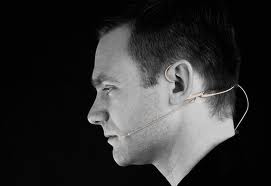In the movie “The King’s Speech”, a BBC announcer prepares to go on the air. A waiter brings him water, and a spray bottle. The announcer gargles and spits into a spittoon that the waiter is holding. The announcer then takes the spray bottle and mists moisture into his mouth. Finally, he sits down in front of the microphone. Using both hands he touches the little finger of his left hand to the microphone, thumb of his left hand to the little finger of his right hand and thumb of his right hand resting on his lips. The microphone is the proper distance away, he’s ready to speak.

Having to use a microphone to give a presentation can be scary, unless you use them regularly. Unfortunately, we don’t have a waiter standing by with water and a spray bottle, or better yet, a glass of wine.
An alternative to fearing a microphone is to learn how to use them.
There are several different types of microphones, hand held, lavaliere, head and lectern.
Lectern microphones are definitely not my favorite. I’m five foot two inches tall, and behind a lectern people can barely see my eyes. Put a microphone in front of me and I disappear. The other huge disadvantage of this type of microphone is you have to stay put for your entire presentation. As Lisa B Marshall (www.publicspeaker.quickanddirtytricks.com) aptly says “Delivering your talk from the lectern limits your ability to make direct connection with your audience. In fact research shows that the physically closer you can get to your audience, the more likely you are to persuade them. Your goal for all presentations should be to make a connection with your audience”.
If you absolutely have to use a lectern mike:
-
Set up the microphone preferably before the audience arrives. Point the microphone at your mouth and keep it about 8 – 10 inches away.
-
If you are unable to do this adjustment before the audience arrives, use the neck of the microphone to make the adjustment. Touching the microphone itself could give some horrible feedback.
-
To move while speaking, pivot around the mike keeping your mouth the same distance from it. It’s definitely awkward and needs practice to look natural.

Hand Held Microphones, preferably wireless so you don’t trip over a wire, need to be spoken over. Hold the ball of the microphone below your mouth, a few centimeters from your face and pointed towards your nose. The best way to do this is to put the ball of the microphone on your chin and leave it there.
Lavaliere microphones are my preference. They attach to your lapel, and have a battery pack that clips to your waistband. Lavalieres allow you to move freely and use both arms for gestures. A few pointers for using lavalieres:
-
You want the microphone to be about eight inches below your chin and as close to the center of your body as possible.
-
Dress appropriately. Wear a jacket or blouse that opens in the front, and have a waistband, or belt to clip the battery pack to, or a pocket to slide it in to. Keep buttons, jewelry, rustling material, and strands of hair away from the mike, otherwise you will be projecting more noises than your voice.
-
As you move and use gestures, keep the microphone the same distance from your mouth. Again Lisa B Marshall has words of wisdom “The secret is to move your entire body in the same direction… If you don’t do that the volume of your voice will vary, which can be very distracting.”
Head microphones are a favorite with singers, actors, entertainers, and speakers. I haven’t used them, but the set up seems perfect. The advantage of the head microphones is if you turn your head, the microphone goes with you, keeping the sound level consistent. They come in different colors to blend with skin tones. The headband is worn behind the head and secures comfortably behind the ear. The optimal placement of the mike is about 1-2 inches from the corner of the mouth.

For all microphones:
-
Know where the on off buttons are. Don’t be caught making a private comment to a room of four hundred people.
-
Speak normally. Include variation in volume, pitch, and rhythm as you would for any great presentation.
-
Do a sound check before your presentation, either with a sound technician (rely on the technician, it’s their area of expertise), or have a friend move to various parts of the room while you talk. Speak a bit louder when the room is full of people.
-
Don’t blow into the mike or hit the top to test if the mike is working. This is annoying to your audience. Speak your first words and listen for amplification, then adjust your voice if there is no audio technician.
-
Practice, practice, practice, preferably with a microphone.
Microphones have come a long way since “The King’s Speech”. You won’t need water, a spittoon, or a spray bottle. A glass of wine would still be nice.
Mary Anthes is a retired business owner, speaker and a Distinguished Toastmaster. She can be reached at nmanthes@shaw.ca
















